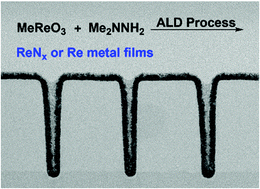Thermal atomic layer deposition of rhenium nitride and rhenium metal thin films using methyltrioxorhenium†
Abstract
The growth of rhenium nitride and rhenium metal thin films is presented using atomic layer deposition (ALD) with the precursors methyltrioxorhenium and 1,1-dimethylhydrazine. Saturative, self-limiting growth was determined at 340 °C for pulse times of ≥4.0 s for methyltrioxorhenium and ≥0.1 s for 1,1-dimethylhydrazine. An ALD window was observed from 340 to 350 °C with a growth rate of about 0.60 Å per cycle. Films grown at 340 °C revealed a root mean square surface roughness of 2.7 nm for a 70 nm thick film and possessed a composition of ReN0.14 with low O and C content of 1.6 and 2.6 at%, respectively. Enhanced nucleation on in situ grown TiN, relative to thermal SiO2, enabled a conformality of 98% on high aspect ratio trenched structures. Subjecting the ReN0.14 thin films to thermal or chemical and thermal treatments reduced the nitrogen content to ≤1.6 at%, yielding a film purity of about 96 at% rhenium and resistivities as low as 51 μΩ cm. The Re metal film thicknesses on the trenched structures remained intact during the post-deposition annealing treatments and the films did not delaminate from the substrate surfaces.

- This article is part of the themed collection: Spotlight Collection: Atomic and Molecular Layer Deposition


 Please wait while we load your content...
Please wait while we load your content...